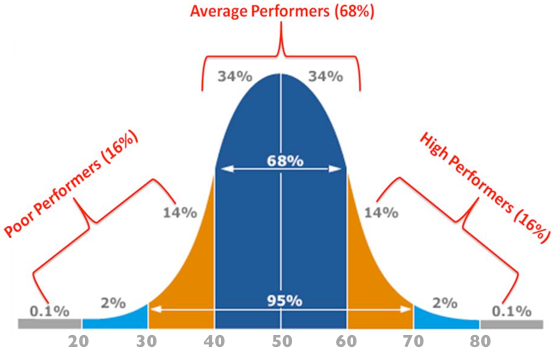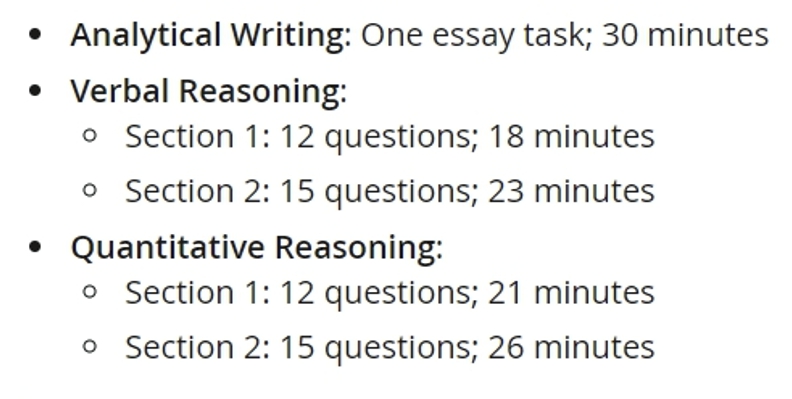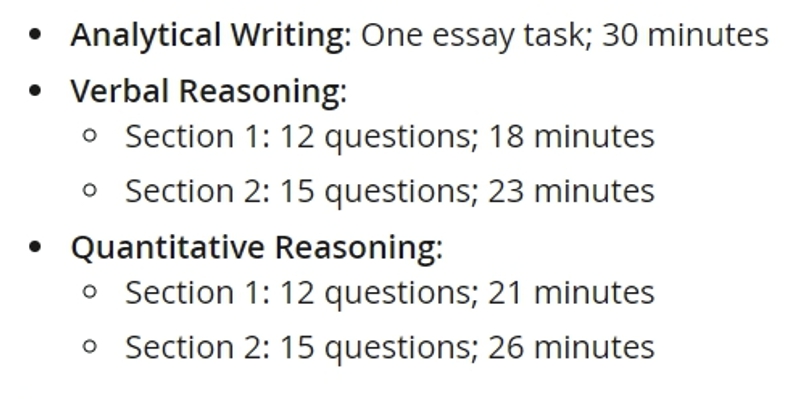
GRE Prep Club Daily Prep
Thank you for using the timer - this advanced tool can estimate your performance and suggest more practice questions. We have subscribed you to Daily Prep Questions via email.
Customized
for You
Track
Your Progress
Practice
Pays
Not interested in getting valuable practice questions and articles delivered to your email? No problem, unsubscribe here.
Shorter GRE - How score is calculated & the new exam pattern
[#permalink]
 Updated on: 08 Oct 2025, 00:48
Updated on: 08 Oct 2025, 00:48
4
Expert Reply
2
Bookmarks
Many students who are beginning to prepare for the GRE often believe that it is question-wise adaptive, similar to other standardized exams such as the GMAT. However, this is a common misconception. The GRE is section-wise adaptive, meaning it adapts to the test-takers skill level within a specific exam section. In this post, we will delve into the adaptive nature of the GRE in detail to aid students in their preparation and help them achieve a high score on the exam.
Even though a section is static, it doesn’t mean that, theoretically, it couldn’t become progressively more challenging. After all, this is what the old GRE, the paper-based 1990 GRE was like. However, there is no order of difficulty on the Revised GRE. The first question can be the hardest, and the last the easiest. Most likely, the first and last questions will be medium ones.
Do not spend 5 minutes trying to answer the question in which four circles are wedged inside some octagon (actually, that would make an interesting question – but another time!). Each question is weighted the same. So the question that gives you the circle's radius and asks for the area, which should take no more than 15 seconds, is worth the same as the one about the monstrous polygon.
The main idea of ETS is to have a mean score in the form of a bell curve.

How the score was calculated, please refer to Adaptive Algorithm of GRE - Explained but with the new shorter GRE something slightly changed.
Look at how the test is structured now. For a complete comparison at a glance between the old format and the new one, please refer to Comparing the Current and Shorter GRE® General Test

Notice how we do have now for two sections - both quant and verbal - a total of 27 questions. Of course, this is crucial to understand how the score for the GRE is calculated. In the old test, we had the above method in which the key part was the following ratio:
The points you can earn, by picking the questions correctly in one point of increment, OVER the # number of questions we have for both sections. In other words, \(\dfrac{40}{40}\) \(= 1\). In the end, 1 was not influential in the calculation \times # number of questions.
Now, instead, we do have FEWER questions - # 27 - and the ratio change: it is the points you can earn - which are still the same 40 even though technically the numbers between 170 and 130 are 41 over the number of questions that are #27
\(\dfrac{40}{27} \approx 1.48148 \times \)# of questions you picked correct in both quant or verbal sections. + The bonus or the penalty
An example, suppose you got 23 questions in quant or verbal does not matter out of 27
\(1.48 \times 23 =34.04 +130 = 164.04\) + hypothetical bonus
We do know the entity of the bonus. I assume that it works like before: the first section is medium, and the second, IF it is easy or medium, you will have a penalty. IF the second one is hard, you will have a bonus point.
However, we DO NOT know how the GRE algorithm works. Other essential elements to take into account during the exam could be:
According to Saadamer11 a nice guy from Pakistan who has had an interview on the GMATClub YouTube channel for his almost perfect GRE score (old format) here, Here also his Instagram Profile
He collected feedback from students who had the new test after September 22 on the new exam pattern. In this discussion https://www.reddit.com/r/GRE/comments/1 ... lFCpc9fxf- we do know that:
It is important to notice how, at the moment, no one has reported the presence of long passages during the exam. Only short passages. This, by no means , implies that the RC portion of the test is easier than before. I would say the contrary because a short passage is even more tricky due to the lack of a canonic and standard structure.

Shorter GRE structure 2023.jpg [ 126.69 KiB | Viewed 55519 times ]

Shorter GRE score and exam pattern 2023.jpg [ 44.9 KiB | Viewed 97505 times ]
Even though a section is static, it doesn’t mean that, theoretically, it couldn’t become progressively more challenging. After all, this is what the old GRE, the paper-based 1990 GRE was like. However, there is no order of difficulty on the Revised GRE. The first question can be the hardest, and the last the easiest. Most likely, the first and last questions will be medium ones.
Do not spend 5 minutes trying to answer the question in which four circles are wedged inside some octagon (actually, that would make an interesting question – but another time!). Each question is weighted the same. So the question that gives you the circle's radius and asks for the area, which should take no more than 15 seconds, is worth the same as the one about the monstrous polygon.
The main idea of ETS is to have a mean score in the form of a bell curve.
From a mathematically standing point
How the score was calculated, please refer to Adaptive Algorithm of GRE - Explained but with the new shorter GRE something slightly changed.
Look at how the test is structured now. For a complete comparison at a glance between the old format and the new one, please refer to Comparing the Current and Shorter GRE® General Test
Notice how we do have now for two sections - both quant and verbal - a total of 27 questions. Of course, this is crucial to understand how the score for the GRE is calculated. In the old test, we had the above method in which the key part was the following ratio:
The points you can earn, by picking the questions correctly in one point of increment, OVER the # number of questions we have for both sections. In other words, \(\dfrac{40}{40}\) \(= 1\). In the end, 1 was not influential in the calculation \times # number of questions.
Now, instead, we do have FEWER questions - # 27 - and the ratio change: it is the points you can earn - which are still the same 40 even though technically the numbers between 170 and 130 are 41 over the number of questions that are #27
\(\dfrac{40}{27} \approx 1.48148 \times \)# of questions you picked correct in both quant or verbal sections. + The bonus or the penalty
An example, suppose you got 23 questions in quant or verbal does not matter out of 27
\(1.48 \times 23 =34.04 +130 = 164.04\) + hypothetical bonus
We do know the entity of the bonus. I assume that it works like before: the first section is medium, and the second, IF it is easy or medium, you will have a penalty. IF the second one is hard, you will have a bonus point.
However, we DO NOT know how the GRE algorithm works. Other essential elements to take into account during the exam could be:
- the difficulty level of the question you pick right or wrong.
- the time to spend replying to a question.
- the number of questions.
- what kind of questions: probability or a tricky algebra question.......
GRE new exam structure
According to Saadamer11 a nice guy from Pakistan who has had an interview on the GMATClub YouTube channel for his almost perfect GRE score (old format) here, Here also his Instagram Profile
He collected feedback from students who had the new test after September 22 on the new exam pattern. In this discussion https://www.reddit.com/r/GRE/comments/1 ... lFCpc9fxf- we do know that:
There were no long passages thrown at any student in any section and there was data interpretation (Q6-8) ONLY in the first section and NOT the second section. There was more focus on sentence equivalence (4 questions in the first section and 3 questions in the second section). First quant section had 4 quantitative comparison questions and the second quant section had 5 quantitative comparison questions. This detailed breakup up might potentially help you.
1st verbal section:
1 single blank, one double blank, 1 Triple blank, 1 short passage of 2 questions each (the short passage was only ONE small paragraph), 4 sentence equivalence and one short to medium passage of 3 questions (2 small paragraphs) Q1)Single Blank Q2)Double Blank Q3)Triple Blank Q4 and Q5 were based on one short passage (one small paragraph) Q6)Sentence Equivalence Q7)Sentence Equivalence Q8)Sentence Equivalence Q9)Sentence Equivalence Q10 to Q12 based on one passage but the passage was not long (you didn’t have to scroll and there were 2 small paragraphs)
1st Quant section:
4 quantitative comparison, 1 question of select one or more, 3 questions on data interpretation (Q6-8 was data interpretation), 3 problem solving questions and 1 numeric entry question.
Q1)Quantitative Comparison Q2)Quantitative Comparison Q3)Quantitative Comparison Q4)Quantitative Comparison Q5)Select one or more Q6-8 were data interpretation Q9)Problem solving Q10)Problem solving Q11)Problem solving Q12)Numeric entry
2nd verbal section:
1 single bank, 1 double blank, 2 triple blank, 1 short passage of 2 questions(one short paragraph), 1 short passage of 3 questions (two short paragraphs), 3 sentence equivalence, 1 critical reasoning, one short passage of 2 questions. Q1)Single blank Q2)Double blank Q3)Triple Blank Q4)Triple Blank Q5 and Q6 were based on one short passage (one small paragraph) Q7-Q9 was based on one short passage (two short paragraphs) Q10)Sentence equivalence Q11)Sentence equivalence Q12)Sentence equivalence Q13)Critical reasoning Q14 and Q15 was based on one short passage (two small paragraph)
2st Quant section:
Q1)Quantitative Comparison Q2)Quantitative Comparison Q3)Quantitative Comparison Q4)Quantitative Comparison Q5)Quantitative Comparison Q6)Problem solving Q7)Problem solving Q8)Problem solving Q9)Problem solving Q10)Problem solving Q11)Select one or more question Q12)Problem solving Q13)Problem solving Q14)Numeric entry Q15)Select one or more question
1st verbal section:
1 single blank, one double blank, 1 Triple blank, 1 short passage of 2 questions each (the short passage was only ONE small paragraph), 4 sentence equivalence and one short to medium passage of 3 questions (2 small paragraphs) Q1)Single Blank Q2)Double Blank Q3)Triple Blank Q4 and Q5 were based on one short passage (one small paragraph) Q6)Sentence Equivalence Q7)Sentence Equivalence Q8)Sentence Equivalence Q9)Sentence Equivalence Q10 to Q12 based on one passage but the passage was not long (you didn’t have to scroll and there were 2 small paragraphs)
1st Quant section:
4 quantitative comparison, 1 question of select one or more, 3 questions on data interpretation (Q6-8 was data interpretation), 3 problem solving questions and 1 numeric entry question.
Q1)Quantitative Comparison Q2)Quantitative Comparison Q3)Quantitative Comparison Q4)Quantitative Comparison Q5)Select one or more Q6-8 were data interpretation Q9)Problem solving Q10)Problem solving Q11)Problem solving Q12)Numeric entry
2nd verbal section:
1 single bank, 1 double blank, 2 triple blank, 1 short passage of 2 questions(one short paragraph), 1 short passage of 3 questions (two short paragraphs), 3 sentence equivalence, 1 critical reasoning, one short passage of 2 questions. Q1)Single blank Q2)Double blank Q3)Triple Blank Q4)Triple Blank Q5 and Q6 were based on one short passage (one small paragraph) Q7-Q9 was based on one short passage (two short paragraphs) Q10)Sentence equivalence Q11)Sentence equivalence Q12)Sentence equivalence Q13)Critical reasoning Q14 and Q15 was based on one short passage (two small paragraph)
2st Quant section:
Q1)Quantitative Comparison Q2)Quantitative Comparison Q3)Quantitative Comparison Q4)Quantitative Comparison Q5)Quantitative Comparison Q6)Problem solving Q7)Problem solving Q8)Problem solving Q9)Problem solving Q10)Problem solving Q11)Select one or more question Q12)Problem solving Q13)Problem solving Q14)Numeric entry Q15)Select one or more question
It is important to notice how, at the moment, no one has reported the presence of long passages during the exam. Only short passages. This, by no means , implies that the RC portion of the test is easier than before. I would say the contrary because a short passage is even more tricky due to the lack of a canonic and standard structure.
Show: ::
Attachment:
Shorter GRE structure 2023.jpg [ 126.69 KiB | Viewed 55519 times ]
Attachment:
Shorter GRE score and exam pattern 2023.jpg [ 44.9 KiB | Viewed 97505 times ]
Re: Shorter GRE - How score is calculated & the new exam pattern
[#permalink]
 05 Oct 2023, 08:56
05 Oct 2023, 08:56
So, boss, what is the point - Is it easier or tougher with the shorter GRE to score more?
Also, someone said that there are 15 questions in the first section and 12 in the second for quant and verbal. Can you/ someone please confirm?
Also, someone said that there are 15 questions in the first section and 12 in the second for quant and verbal. Can you/ someone please confirm?
Re: Shorter GRE - How score is calculated & the new exam pattern
[#permalink]
 05 Oct 2023, 10:03
05 Oct 2023, 10:03
2
Expert Reply
The image above about the unfolding of the test is reliable. I read also what you mentioned but for me, that is the way the exam should be. See in addition the pattern above. It confirms 12+15
Guys, when I write something is not just to throw out a post. I work hard to give the most reliable information
Moreover, the exam is like before: hard as a nail. It is just short.
Even Gregmat who had a perfect score a week ago, confirmed that the test is pretty much the same: not easier not tougher than before. Just short.
And as I mentioned: NO long reading until now.
Also, I saw how the passages now look like and are quite tricky
Guys, when I write something is not just to throw out a post. I work hard to give the most reliable information
Moreover, the exam is like before: hard as a nail. It is just short.
Even Gregmat who had a perfect score a week ago, confirmed that the test is pretty much the same: not easier not tougher than before. Just short.
And as I mentioned: NO long reading until now.
Also, I saw how the passages now look like and are quite tricky



